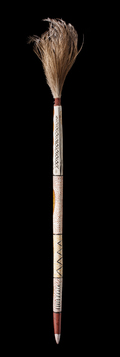| Coordinates WGS84 | 16°31'S, 139°24'E -16.52, 139.41 |
NMA1985_0209_0001
Title: A message stick from Queensland in the National Museum of Australia
Description: Cylindrical, wooden shafted message stick with a pointed lower end and a tuft of emu feathers bound to the truncated end with fibre string, pigmented overall in geometric designs and dots on a white background. The Dick and Lindsay Roughsey Collection comprises a cylindrical, wooden, message stick with a pointed lower end and a tuft of emu feathers bound with red fibre string. The surface of the message stick, painted by Mornington Island artists and brothers Dick and Lindsay Roughsey, is covered with goodwill symbols painted in black, yellow, red and white in geometric designs and lines, dots and dashes on a white background. It was presented to prominent scholar of Aboriginal studies, Dr F. D. McCarthy, in Canberra in 1972. Although not universal throughout Aboriginal Australia, message sticks were used by many tribes, including Lardil people, for various reasons including the coordination of large socio-economic events, to summon others for initiation ceremonies, for hostile purposes or to convey messages relating to sickness or death. Traditional message or 'talking' sticks were made of soft wood, ornamented, carved and often painted bright colours, and marked in various ways with notches, dots, strokes, curves and geometric designs. Lardil artists and brothers, Dick (Goobalathaldin) and Lindsay (Burud), Roughsey, were prominent in reviving and preserving the art culture of the Lardil people which has a long history stemming from traditions of body painting and shows strong affinities to ceremonial designs stretching to Central Australia. Beginning with bark painting, inspired by his visits to Arnhem Land in the 1950s, Dick Roughsey, OBE, went on to become internationally renowned for his children's books and remains one of Australia?s most significant artists. His talented older brother Lindsay, also known as 'Spider', was a source of inspiration to younger artists and at the heart of the history of Lardil painting from the early 1960s until his death in 2007.
Creator of Object: Dick and Lindsay Roughsey According to NMA: "This message stick, carrying symbols of goodwill, was painted by Dick and Lindsay Roughsey and presented to Mr FD McCarthy, the Principal of the Australian Institute of Aboriginal Studies in May 1972, at the opening of an exhibtion of their art held at the Macquarie Galleries in Manuka, Canberra."
Date Created: 1972
Notes on date created: terminus ante quem
Item type: message stick in a collection
Subtype: political
State/Territory: QLD
Linguistic area 1: Chirila: Lardil Austlang: G38 - Lardil Glottolog: lard1243
Notes on linguistic areas: The message stick is associated with Mornington Island, Queensland, Australia
Dimension 1: 1400mm Dimension 2: 300mm Dimension 3: 100mm
Materials: feather, fibre string, pigment, wood
Source types: museum collection
Institution/Holder file: The National Museum of Australia object identifier: 1985.0209.0001
Collector: Dick and Lindsay Roughsey collection Date received at Australian Institute of Anatomy: 1972
Coordinates: 16°31'3.000000"S,139°24'21.200400"E (-16.5175, 139.405889)
Media copyright: The National Museum of Australia
URL institution: http://collectionsearch.nma.gov.au/ce/message%20stick?&object=19628
IRN: 19628
Notes: This is the longest object in the AMSD. Accordign to NMA: "The Dick and Lindsay Roughsey Collection comprises a cylindrical, wooden, message stick with a pointed lower end and a tuft of emu feathers bound with red fibre string. The surface of the message stick, painted by Mornington Island artists and brothers Dick and Lindsay Roughsey, is covered with goodwill symbols painted in black, yellow, red and white in geometric designs and lines, dots and dashes on a white background. It was presented to prominentscholar of Aboriginal studies, Dr F. D. McCarthy, in Canberra in 1972. Although not universal throughout Aboriginal Australia, message sticks were used by many tribes, including Lardil people, for various reasons including the coordination of large socio-economic events, to summon others for initiation ceremonies, for hostile purposes or to convey messages relating to sickness or death. Traditional message or `talking’ sticks were made of soft wood, ornamented, carved and often painted bright colours, and marked in various ways with notches, dots, strokes, curves and geometric designs. Lardil artists and brothers, Dick (Goobalathaldin) and Lindsay (Burud), Roughsey, were prominent in reviving and preserving the art culture of the Lardil people which has a long history stemming from traditions of body painting and shows strong affinities to ceremonial designs stretching to Central Australia. Beginning with bark painting, inspired by his visits to Arnhem Land in the 1950s, Dick Roughsey, OBE, went on to become internationally renowned for his children's books and remains one of Australia’s most significant artists. His talented older brother Lindsay, also known as 'Spider', was a source of inspiration to younger artists and at the heart of the history of Lardil painting from the early 1960s until his death in 2007."
Media Files:
Data Entry: Olena Tykhostup, Piers Kelly




